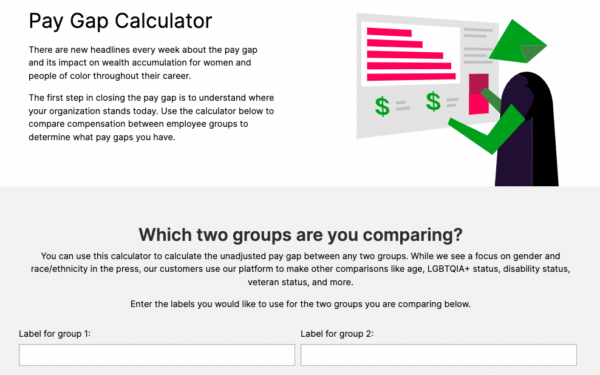As the push for pay transparency gains momentum, companies are feeling the heat when it comes to addressing their pay gap stories. With laws on the books requiring public salary ranges in several U.S. states and the reporting of median pay gaps becoming mandatory in California and Illinois, it’s clear that the tide is turning. And it’s a global movement — the UK started a trend that other countries in Europe have followed, and the rest of Europe is set to follow suit thanks to the recently passed EU Directive on Equal Pay and Transparency.
Increasing transparency means that employees will know what other jobs in their company pay — and who is in the roles that pay more. The result? The spotlight of pay transparency doesn’t just shine on pay equity, but also on representation gaps. While achieving “equal pay for equal work” is a great milestone, it may not necessarily address pay gaps resulting from unbalanced representation in leadership positions and other higher-paying roles.
Companies need to get ahead of their pay gaps now, and proactively communicate about them, before employees, job seekers, and investors start making assumptions and reaching their own potentially damaging conclusions. Learn how to calculate the gender pay gap (or any other demographic-based pay gap) in your organization — and what to do about it — below.
Pay gap definitions
The unadjusted/median pay gap matters because it reflects the fact that pay equity alone is not enough to explain pay gaps — it’s also driven by systemic opportunity inequities such as promotion gaps and disproportionate underrepresentation in higher-paying leadership roles. For example, a recent study showed that despite receiving higher performance ratings than men on average, women received lower potential ratings than men, which resulted in women being 13% less likely to be promoted than men. Gender promotion gaps like this contribute to women getting stuck in lower rungs of their organization where they have lower average pay — perpetuating overall gender pay gaps within companies.
How to calculate your company’s gender pay gap (or any other demographic-based pay gap)
The first step in closing your pay gap is to understand where your organization stands today. You can use Syndio’s Pay Gap Calculator to compare compensation between employee groups to determine what pay gaps you have.

To use the calculator, you need to know:
- The number of employees in each group you’re comparing
- The average compensation for each group
Strategies to address and communicate about pay gaps
Pay equity (“equal pay for equal work”) is one of the biggest explainers of the pay gap and is often the easiest and most natural place to start for most organizations when it comes to closing the pay gap, because pay equity is entirely within a company’s control to solve through statistical analysis and remediation.
However, as discussed above, pay equity alone doesn’t fully account for the unadjusted pay gap. Employers also need to address opportunity equity, meaning that employees have equivalent access to opportunities for employment, advancement, and development — regardless of gender, race, or other factors of identity. To improve opportunity equity, companies must analyze their recruiting, hiring, onboarding, and promotion policies and ensure they are consistently, objectively, fairly, and equitably enforced for all employees and job candidates.
Syndio’s Workplace Equity Analytics Platform makes it easy to tackle pay gaps from both sides — pay equity and opportunity equity.
The next step is to create a communications strategy around your pay gap story to stakeholders such as your leadership, board, investors, and employees — where you stand and what you’re doing to improve your numbers. Syndio has a bundle of workplace equity communications resources, including a Communications Playbook, a Lookbook of real-world comms examples, and a webinar, to help you plan and execute your pay gap communications strategy.
Where does your pay gap stand?
Salary ranges and pay gaps are going public. Companies should begin taking action around their pay gap now, before someone else tells their pay gap story for them. No company is perfect — by talking about where you stand, where you are headed, and what you are doing to get there, you build trust with your employees, customers, and other stakeholders.
Step 1: Calculate your unadjusted pay gaps with our pay gap calculator below. (You can also check out my Youtube video on the topic). Step 2: Create an action plan to analyze and address workplace equity issues, including pay inequities and opportunity inequities. Step 3: Build a communication strategy around your pay gap narrative. Together, these steps can feel like a lot, but you don’t have to tackle it alone. The Syndio team has a wealth of expertise in compensation best practices, statistical analyses, legal compliance, and corporate communications — and we’re standing by to help.
The information provided herein does not, and is not intended to, constitute legal advice. All information, content, and materials are provided for general informational purposes only. The links to third-party or government websites are offered for the convenience of the reader; Syndio is not responsible for the contents on linked pages.


